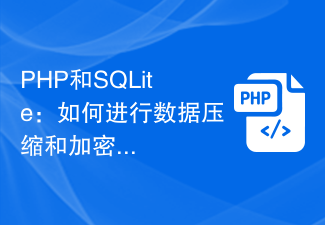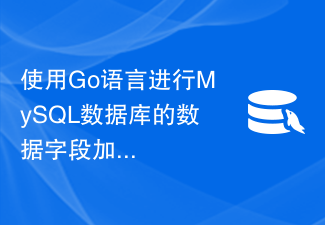PHP and SOAP: How to Encrypt and Decrypt Data
With the development of the Internet, data security has become more and more important. Encryption and decryption are indispensable technologies when transmitting sensitive data. This article will introduce how PHP and SOAP implement data encryption and decryption, and provide corresponding code examples.
SOAP (Simple Object Access Protocol) is a communication protocol used to exchange structured information. Through SOAP, different applications can communicate with each other and do not need to worry about what the underlying communication protocol is. When transmitting data, SOAP uses HTTP as the transmission protocol, so HTTPS can be used to ensure the encryption and decryption of data.
First, we need an encryption algorithm to encrypt and decrypt data. In this article, we will use the AES algorithm (Advanced Encryption Standard) for encryption and decryption operations. PHP provides the OpenSSL extension, which can easily use the AES algorithm for data encryption and decryption.
The following is a sample code that demonstrates how to use the AES algorithm and SOAP to implement data encryption and decryption.
// 定义加密密钥
$key = "0123456789abcdef";
// 加密函数
function encrypt($data, $key) {
// 生成随机的初始化向量(IV)
$iv = openssl_random_pseudo_bytes(openssl_cipher_iv_length('aes-256-cbc'));
// 使用AES算法进行加密
$encrypted = openssl_encrypt($data, 'aes-256-cbc', $key, 0, $iv);
// 将加密后的数据和IV拼接起来
$result = base64_encode($iv . $encrypted);
return $result;
}
// 解密函数
function decrypt($encryptedData, $key) {
// 将加密后的数据解码
$decoded = base64_decode($encryptedData);
// 提取初始化向量(IV)
$ivLength = openssl_cipher_iv_length('aes-256-cbc');
$iv = substr($decoded, 0, $ivLength);
// 提取加密后的数据
$encrypted = substr($decoded, $ivLength);
// 使用AES算法进行解密
$decrypted = openssl_decrypt($encrypted, 'aes-256-cbc', $key, 0, $iv);
return $decrypted;
}
// 生成加密后的数据
$originalData = "Hello, world!";
$encryptedData = encrypt($originalData, $key);
// 解密数据
$decryptedData = decrypt($encryptedData, $key);
// 输出结果
echo "加密前的数据: " . $originalData . "
";
echo "加密后的数据: " . $encryptedData . "
";
echo "解密后的数据: " . $decryptedData . "
";The above code first defines an encryption key $key, and then defines the encrypt and decrypt functions for encrypting and decrypting data respectively. In the encryption function, we use the openssl_random_pseudo_bytes function to generate a random initialization vector (IV), then use the openssl_encrypt function to encrypt the data, and finally concatenate the encrypted data and IV and use the base64_encode function to encode. In the decryption function, we first use the base64_decode function to decode, then extract the IV and encrypted data, and finally use the openssl_decrypt function to decrypt the data.
Run the above code, you can see the output as follows:
加密前的数据: Hello, world! 加密后的数据: XE5TLrULHYZSNrBFI9Wm6+nViAHlyV6W2/5sevjpa3w= 解密后的数据: Hello, world!
As can be seen from the output, the original data has been restored after encryption and decryption.
Summary:
By using the AES algorithm and SOAP, we can easily implement data encryption and decryption. Encryption algorithms can protect the security of sensitive data during transmission, making it less likely to be maliciously obtained and tampered with. In practical applications, we can also combine other security measures, such as digital certificates and access control, to further enhance data security.
The above is the detailed content of PHP and SOAP: How to Encrypt and Decrypt Data. For more information, please follow other related articles on the PHP Chinese website!
 PHP和SQLite:如何进行数据压缩和加密Jul 29, 2023 am 08:36 AM
PHP和SQLite:如何进行数据压缩和加密Jul 29, 2023 am 08:36 AMPHP和SQLite:如何进行数据压缩和加密在许多Web应用程序中,数据的安全性和存储空间的利用率是非常重要的考虑因素。PHP和SQLite是两个非常广泛使用的工具,本文将介绍如何使用它们来进行数据压缩和加密。SQLite是一种轻量级的嵌入式数据库引擎,它没有独立的服务器进程,而是直接与应用程序进行交互。PHP是一种流行的服务器端脚本语言,被广泛用于构建动态
 如何在MySQL中进行数据的加密和解密存储?Jul 30, 2023 pm 09:13 PM
如何在MySQL中进行数据的加密和解密存储?Jul 30, 2023 pm 09:13 PM如何在MySQL中进行数据的加密和解密存储?摘要:数据安全是数据库管理的重要方面。本文将介绍如何在MySQL中使用加密算法对数据进行加密和解密存储,以提高数据的安全性。一、引言在现代的信息社会中,数据安全问题变得越来越重要。数据库中存储的数据可能会包含敏感信息,如用户密码、银行账号等。为了防止数据泄露和非法获取,我们需要对这些敏感信息进行加密存储。MySQL
 Golang中使用gRPC实现数据加密的最佳实践Jul 19, 2023 pm 03:17 PM
Golang中使用gRPC实现数据加密的最佳实践Jul 19, 2023 pm 03:17 PMGolang中使用gRPC实现数据加密的最佳实践引言:在当今信息安全高度重视的时代,保护数据的安全性变得越来越重要。而在分布式系统中,如何保证数据在网络传输过程中的安全性,是一个必须关注的问题。gRPC是一种高性能、跨语言的远程过程调用框架,它通过使用ProtocolBuffers进行数据序列化和传输,并支持TLS/SSL加密传输,从而可以提供更高的数据安
 MySQL和Oracle:对于数据加密和安全传输的支持程度比较Jul 12, 2023 am 10:29 AM
MySQL和Oracle:对于数据加密和安全传输的支持程度比较Jul 12, 2023 am 10:29 AMMySQL和Oracle:对于数据加密和安全传输的支持程度比较引言:数据安全在如今的信息时代中变得愈发重要。从个人隐私到商业机密,保持数据的机密性和完整性对于任何组织来说都至关重要。在数据库管理系统(DBMS)中,MySQL和Oracle是两个最受欢迎的选项。在本文中,我们将比较MySQL和Oracle在数据加密和安全传输方面的支持程度,并提供一些代码示例。
 基于Java的数据加密方法和实现Jun 18, 2023 pm 09:22 PM
基于Java的数据加密方法和实现Jun 18, 2023 pm 09:22 PM随着信息技术的发展,人们越来越重视数据加密的安全性。数据加密是保障数据安全的重要手段。在数据加密的过程中,应用程序需要使用一种加密算法,保障敏感数据在传输和存储过程中不被非法窃取、篡改或泄露。本文将介绍一种基于Java的数据加密方法和实现,为数据安全提供保障。什么是加密算法?加密算法是一种将数据用特定方法计算出密文的过程。密文是一种难以理解的数据形式,只有使
 PHP中如何进行数据安全和信息隐私保护?May 21, 2023 pm 08:21 PM
PHP中如何进行数据安全和信息隐私保护?May 21, 2023 pm 08:21 PM随着互联网的快速发展,数据安全和信息隐私保护变得越来越重要。尤其是在Web应用程序中,用户的敏感数据和隐私信息需要得到有效的保护。PHP是一种流行的服务器端编程语言,它可以被用来构建强大的Web应用程序。但是,PHP开发人员需要采取一些措施来确保数据的安全和保护用户的隐私。以下是一些关于在PHP中进行数据安全和信息隐私保护的建议。使用密码哈希算法密码哈希算法
 使用Go语言进行MySQL数据库的数据字段加密的方法Jun 17, 2023 pm 06:34 PM
使用Go语言进行MySQL数据库的数据字段加密的方法Jun 17, 2023 pm 06:34 PM随着数据库安全问题的日益凸显,对数据进行加密处理已成为一种必要的措施。而Go语言的高效性和简洁性,使其备受关注,特别是在Web开发领域中被广泛应用。本文将介绍如何使用Go语言实现MySQL数据库中数据字段的加密处理。一、MySQL数据库字段加密的意义在现代信息化的时代背景下,数据库系统已变得越来越重要。然而,由于威胁不断增加,数据库安全成为企业和组织面临的主
 使用PHP数组实现数据加密和解密的方法和技巧Jul 16, 2023 pm 04:02 PM
使用PHP数组实现数据加密和解密的方法和技巧Jul 16, 2023 pm 04:02 PM使用PHP数组实现数据加密和解密的方法和技巧摘要:数据加密在信息安全中扮演着重要的角色。本文将介绍使用PHP数组实现数据加密和解密的方法和技巧,以便保护敏感信息的安全。引言在现代社会,网络安全问题日益引起人们的关注。为了保护敏感信息的安全,数据加密是一种常用的方式。PHP数组是一种强大而灵活的数据结构,可以用于存储和操作数据。通过将敏感数据存储在PHP数组中


Hot AI Tools

Undresser.AI Undress
AI-powered app for creating realistic nude photos

AI Clothes Remover
Online AI tool for removing clothes from photos.

Undress AI Tool
Undress images for free

Clothoff.io
AI clothes remover

AI Hentai Generator
Generate AI Hentai for free.

Hot Article

Hot Tools

SublimeText3 Mac version
God-level code editing software (SublimeText3)

Dreamweaver CS6
Visual web development tools

ZendStudio 13.5.1 Mac
Powerful PHP integrated development environment

Safe Exam Browser
Safe Exam Browser is a secure browser environment for taking online exams securely. This software turns any computer into a secure workstation. It controls access to any utility and prevents students from using unauthorized resources.

PhpStorm Mac version
The latest (2018.2.1) professional PHP integrated development tool






